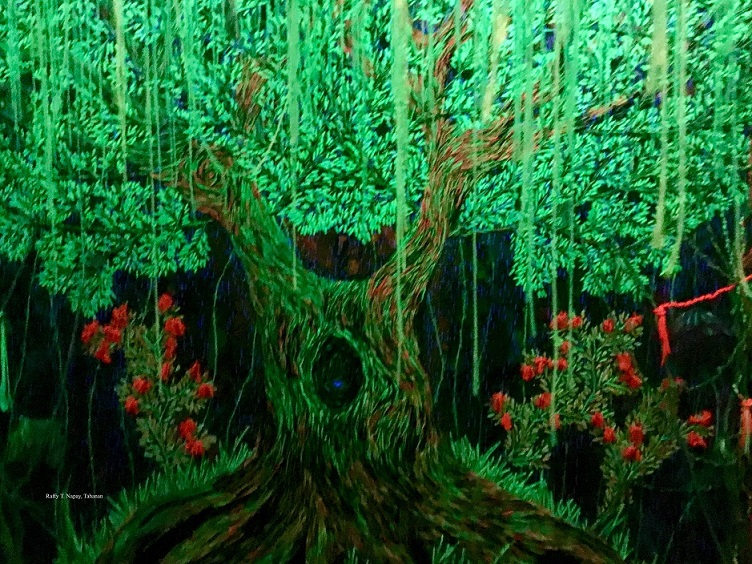
Guerrero Z. Habulan, Tres Marias
The Thirteen Artists Award 2018 has been bestowed by the Cultural Center of the Philippines to a new batch, namely Zeus Bascon (b. 1987), Bea Camacho (b. 1983), Cian Dayrit (b.1989), Janos Delacruz (b. 1986), Doktor Karayom (b. 1990), Carlo Gabuco (b. 1981), Dina Gadia (b. 1986), Guerrero Z. Habulan (b.1980), Eisa Jocson (b. 1986), Raffy T. Napay (b. 1986), Archie Oclos (b. 1989), Lynryd Paras (b. 1982), and Shireen Seno (b. 1984).
Representing a wide range of artistic practice, the artists work with film, photography, print , performance, dance, painting, and sculpture. Through conventional and digital platforms, they explore the socio-political reality ofwhat it means to be a Filipino in a time of falsehood and pervasive acts of impunity.

Janos Delacruz, Trece
Standouts
Nanlaban? In Carlo Gabuco’s The Other Side of Town, the artist leads us into places where we fear to go. Dark and shadowy photographs document the ongoing drug war and state-sanctioned killings. An eight-channel video installation plays similar scenes. Amidst images of everyday killings as staple news, do we still feel and see? A fine arts (painting) graduate of Philippine Women’s University, Gabuco earned a spot in the British Journal of Photography’s Ones to Watch List in 2017. Consequently, a Magnum Foundation grant resulted in Less Than Human, a documentary that chronicles the Duterte administration’s brutal drug war as seen through the eyes of the children left behind and its long-term effects on society.
Painter and printmaker, Janos Delacruz, a University of Santo Tomas graduate in advertising arts, offers Trece —13 figures in mixed media on canvas. Hyper-detailed images and drawings fill every square inch of each canvas. He says that it is a Filipino version of the Last Supper in a political setting, a fairy tale of politics and religion, a mixture of fantasy and social reality.

Doktor Karayom, Isla Inip
A fine arts graduate in visual communication from the University of the Philippines, Guerrero Z. Habulan presents works that blend”the macabre with the whimsical and the surreal” as seen in four portraits (Tres Marias, Death of Easter Bunny, Those Who Chirp and Mutter, Kara Cruz) and an installation, Contamina, of Christ and Mary with a video of Holy Week flagellants hitting themselves with a cluster of bloody bamboo whips. A constant in these works: the black-and-white polka dots, Disneyesque cartoon figures, and flying birds. With fragmented mental states popping out, the superimposed faces of Filipinos and foreign ones raise questions of identity, once more.
Known for his use of the color red, Doktor Karayom presents Isla Inip, (an anagram for Pilipinas), an interactive board game with a 13-foot man, representing Jose Rizal’s dissected body, filled with tiny figurines. A Lilliputian island overpopulated, unsustainable, and stalked by disease and death, a metaphor for our social issues, festering and festering. A fine arts (advertising) graduate of the Technological Institute of the Philippines, he had a solo show at the CCP in 2016, Linya, made up of 300 resin figures inspired by individuals he met while standing in line. It was shortlisted for the 2017 Ateneo Art Awards.
Taught by his mother, a seamstress, on how to use a sewing machine, Raffy T. Napay uses needles, threads, textile, and lights to weave ideas about roots and interconnectedness. In a site-specific installation, Tahanan, he creates a safe place and a haven for a family. One enters a lush green forest, filled with hanging vines, leaves, and flowers of yarns and knotted cords simulating a verdant space, glowing in the dark. Its luminosity heightens the textural surface created by the intertwined threads and fabric. An advertisinggraduate of Eulogio Amang Rodriguez Institute of Science and Technology, he was the winner of theAteneo Art Award in 2013; in 2015,hereceived the Second Award in textile art at the ‘Lorenzo il Magnifico’ International Award, Florence Biennale, Italy.

Archie Oclos, Bayang Magiliw…
A University of the Philippines fine arts (painting) graduate, Archie Oclos is a street artist who believes in giving a voice to the marginalized and voiceless. His murals in public spaces tackle issues of the day, especially those affecting the Filipino farmers, the indigenous people, and the dispossessed. In his work, Bayang Magiliw…, he depicted the back of the heads of students, activists, and rice farmers on NFA rice sacks. In 2018, he was one of those honored in Forbes’ 30 Under 30, Asia.
History
The Thirteen Artists Award started in 1970. Initially, it given every two years; in 2009, it became a triennial event, “to mark the turnings in of Philippine contemporary art… to assess how artists today engage with other forces in the art world.” Now on its 17th year, a total of 198 artists have received the award, a number of whom are fathers-and-sons (Romulo Olazo, 1972 and Jonathan Olazo, 1994; Fil Delacruz, 1992 and Janos Delacruz, 2018; Renato Habulan, 1990 and Guerrero Habulan, 2018) or mothers-and-daughters (Julie Lluch, 1990; Sari, 2000 and Kiri Lluch Dalena, 2012.)
Curated by Ronald Achacoso, a 2000 awardee, the exhibit runs until 23 December 2018, Cultural Center of the Philippines.

Raffy T. Napay, Tahanan